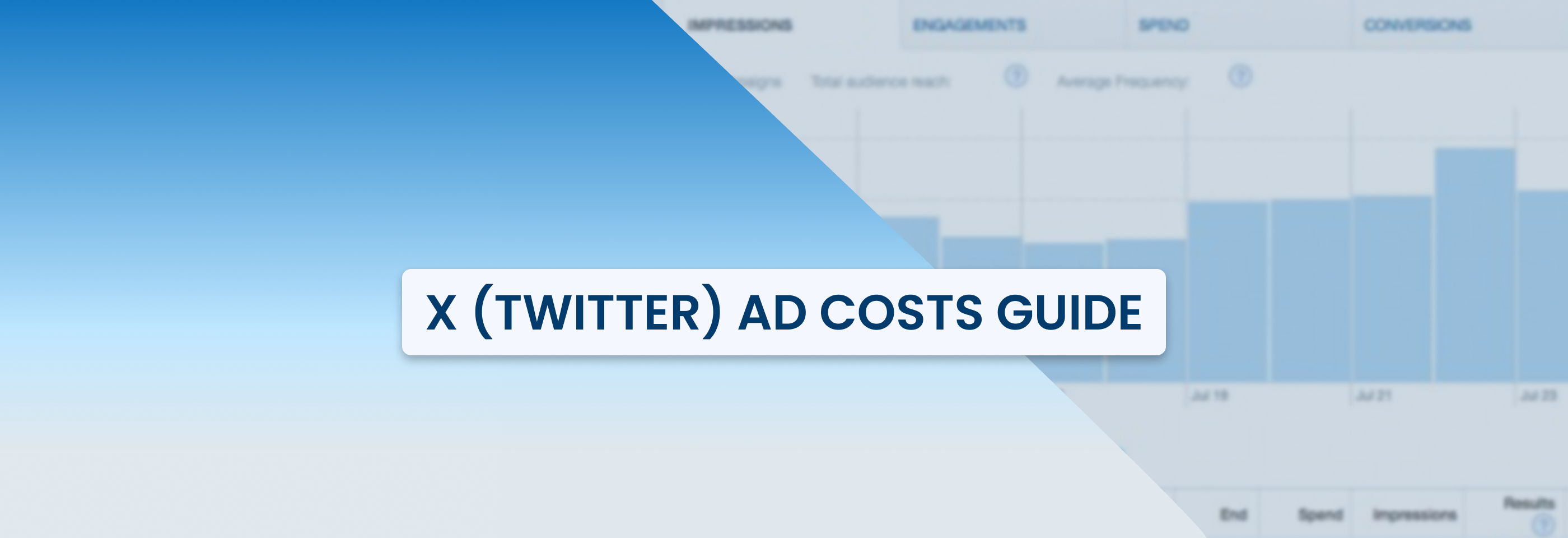Facebook Ad Targeting Basics for Maximum Results
2024-05-13
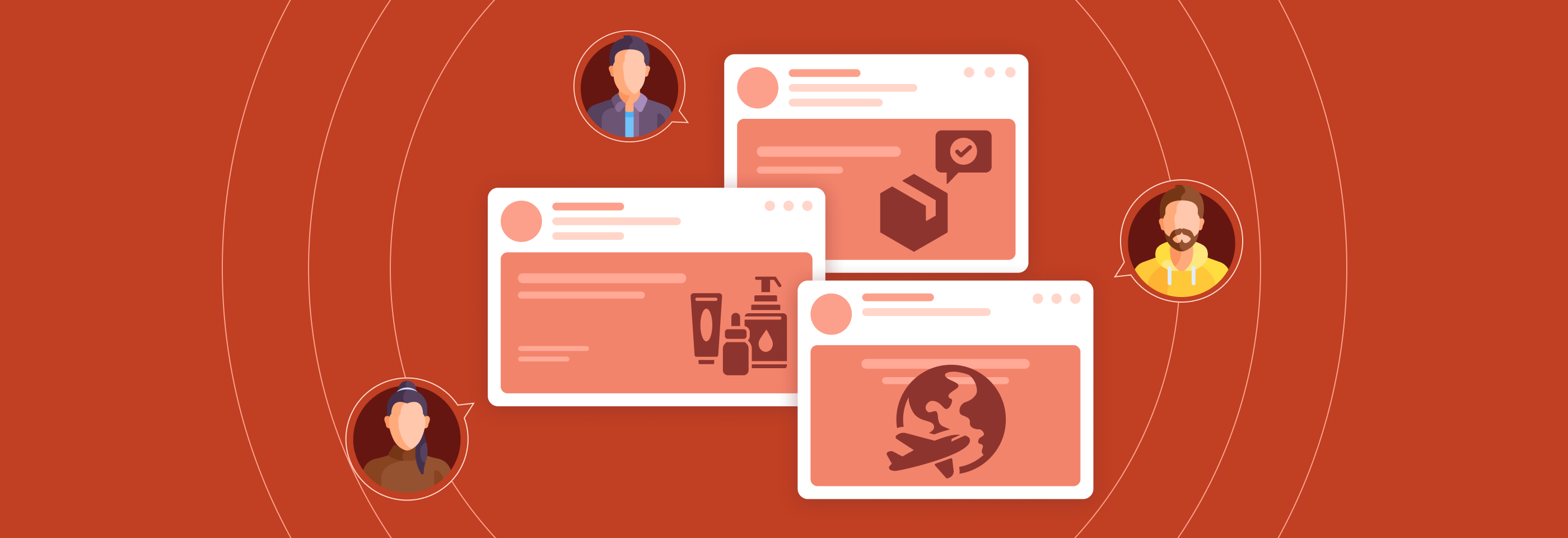
Facebook advertising can deliver great results not only for big advertisers: small businesses can benefit from Facebook ads as well. However, it’s crucial to understand what you can expect from running ads on Facebook and most importantly, how much it can cost you and how you can avoid wasting your ad budget in vain.
We’ve already explored what determines how much you’ll pay for your ad campaigns in our Facebook ad costs guide, and one of the most influential factors is undoubtedly your target audience.
Let’s dive deeper into the topic and explore how Facebook ad targeting works, what types of target audiences you can select, and how to make the right choice.
How Facebook ad targeting works
The basic definition of a target audience in digital advertising is a particular group of people that advertisers want to reach with their ads. They can choose this group based on things like age, interests, where they live, what they do online, and so on.
The main purpose of selecting a target audience for ad campaigns is to make sure the ads are seen by the right people who are most likely to be interested in what's being advertised. Basically, being precise with your targeting allows you to make your ads more relevant, and the more relevant your ads are, the better ad performance will be.
Facebook is famous among social media advertisers for its targeting capabilities, and there’s a good reason for this. Facebook uses a lot of information about its users to show them ads that they might be interested in: it considers things like age, what people like, where they live, and what they do on Facebook. This data is then used to decide which ads to show to which people.
So, Facebook advertising is all about using data to make sure the right ads are displayed to the right audiences. Let’s see how exactly it is done by going through the available targeting options.
The main Facebook ad targeting options
When deciding who to target with your ads, you have two choices: you can either make a brand new audience or use one you've saved before.
Here’s a detailed breakdown of the main Facebook ad targeting options:
1. Core audiences
This is the automatic option available at the Ad Set level in your Ads Manager.
When you create a Core Audience, you can choose who will see your ads based on the following characteristics:
- Locations: you can target your Facebook ads to people based on where they are, e.g., by choosing specific countries, states, cities, and so on. You can target globally, by region (like "Europe"), by trade area (like "NAFTA"), or by app store availability (like "iTunes app store countries").
- Age: you can choose the age range of the people you want to target, e.g., from 18 to 35 years old if you want to target younger users.
- Gender: you can decide if you want to target women, men, or everyone. Languages: you can also target people who speak specific languages.
There’s also a Detailed Targeting option that allows you to further refine your audience by including or excluding people based on their demographics, interests, and behaviors. Moreover, detailed targeting lets you target people based on the ads and pages they engage with, their device usage, and so on.
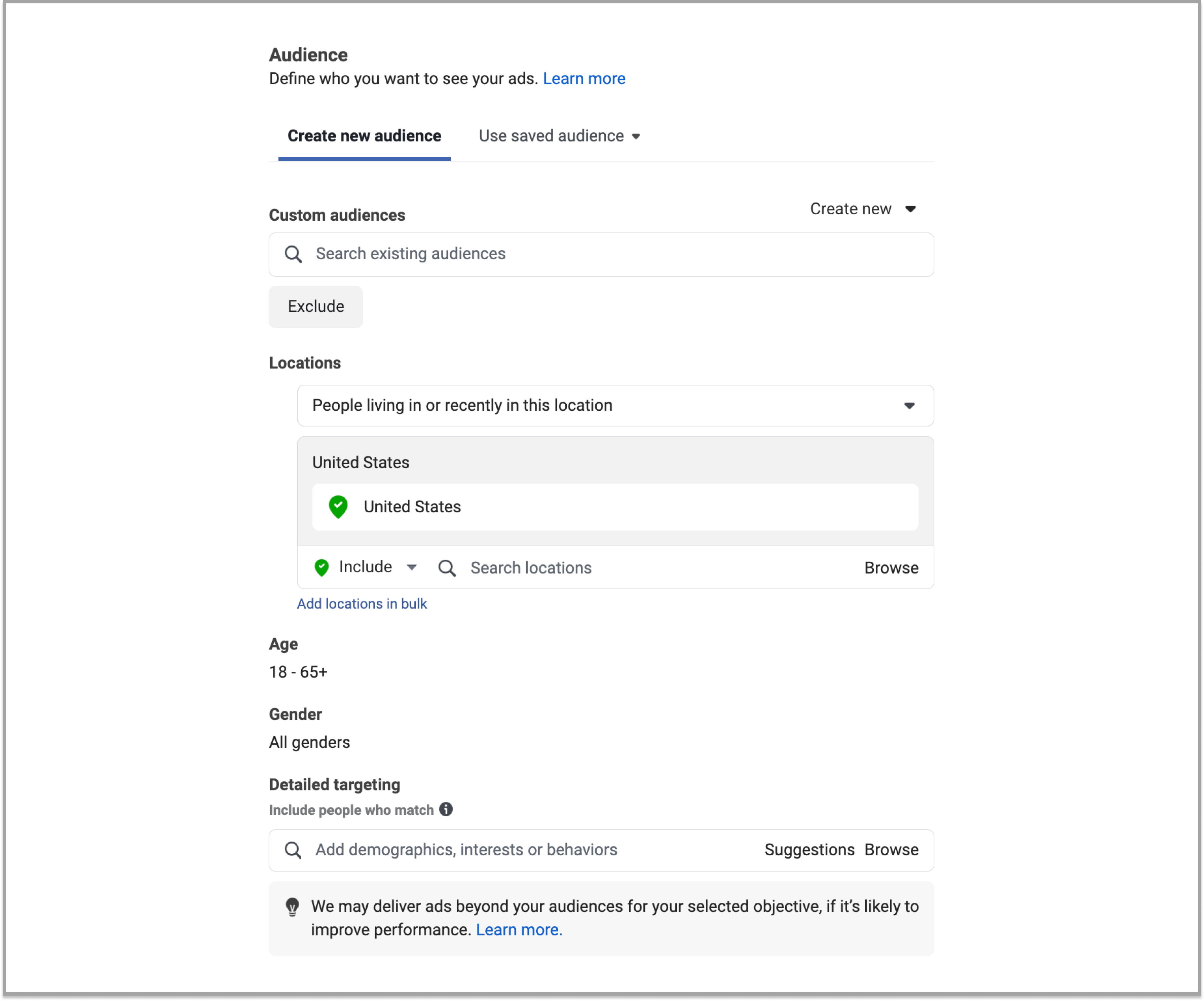
Here's how the targeting step looks like in the Facebook Ads Manager.
You can choose up to 100 options for targeting your Facebook ads and stack different filters together for a more precise audience. Keep in mind that you can save your core audiences for future campaigns: this will make the process of setting everything up a lot easier.
To sum up, core audiences are typically cold audiences: they allow you to discover new customers who are just about to enter your conversion funnel. These people may not be as interested in converting as warm audiences that we’ll talk about next, but they are crucial for populating your funnel in the first place.
When running ad campaigns for them, consider offering them something that doesn’t take a lot of commitment to do, like signing up for a trial, subscribing to your mailing list, and so on.
2. Custom audiences
This is another targeting option available in the Ads Manager – custom audiences, which help you reach out to people who are already interested in your business. They are created from the information that you provide or the data that Meta collects.
With custom audiences, you can target users who:
Custom audiences on Facebook offer several important benefits:
- Higher ROI: since custom audiences include people who already have some connection to the business, like visiting their website or signing up for their emails, your ads will be more likely to grab their attention and lead them to take action.
- Personalization: custom audiences help you create personalized ads that speak directly to the interests and needs of your target audience. This makes your ads more relevant and engaging, increasing the chances of new conversions.
- Cost-effectiveness: targeting custom audiences can be more cost-effective because you will only show your ads to people who are more likely to be interested in your products or services. While they can cost more than core audiences, you won’t be wasting money on reaching people who aren't likely to convert, thus getting attention only from relevant users.
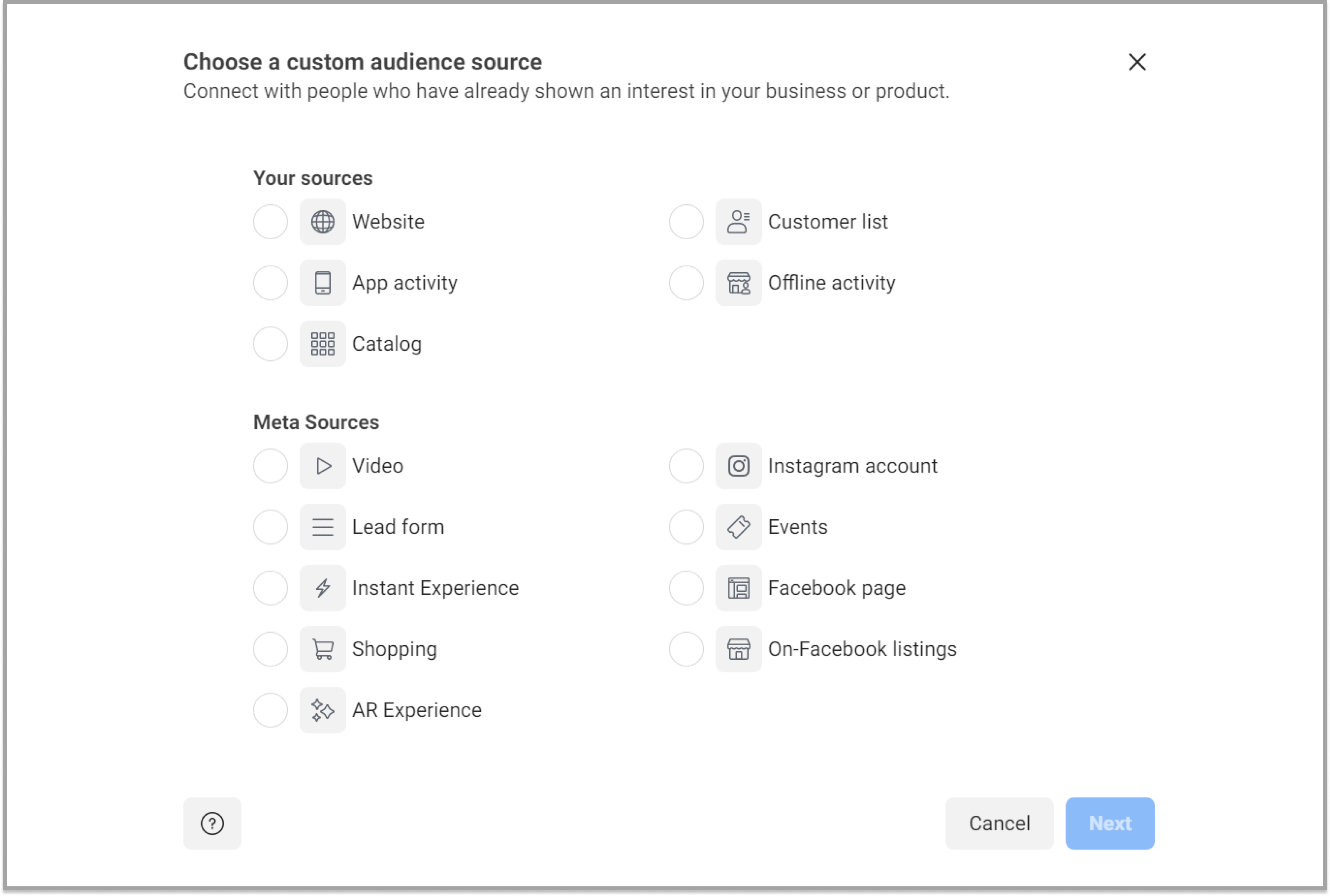
There are multiple sources you can choose for creating Facebook Custom Audiences.
In short, using custom audiences for Facebook ads can help you reach the right people with the right message and get a better ROI in return. Warm audiences like these belong to the last stages of your conversion funnel, which means that they are close to taking the action you want them to.
3. Lookalike audiences
Besides core and custom audiences, Facebook also allows you to use Lookalike audiences to discover new people similar to your existing customers. This approach combines the best of both cold and warm audiences, creating new targeting opportunities for you.
To create a lookalike audience, you’ll need to choose one of your custom audiences as your starting point. Facebook will use demographic, psychographic, and behavioral data about users from your original audience to find new people who are similar.
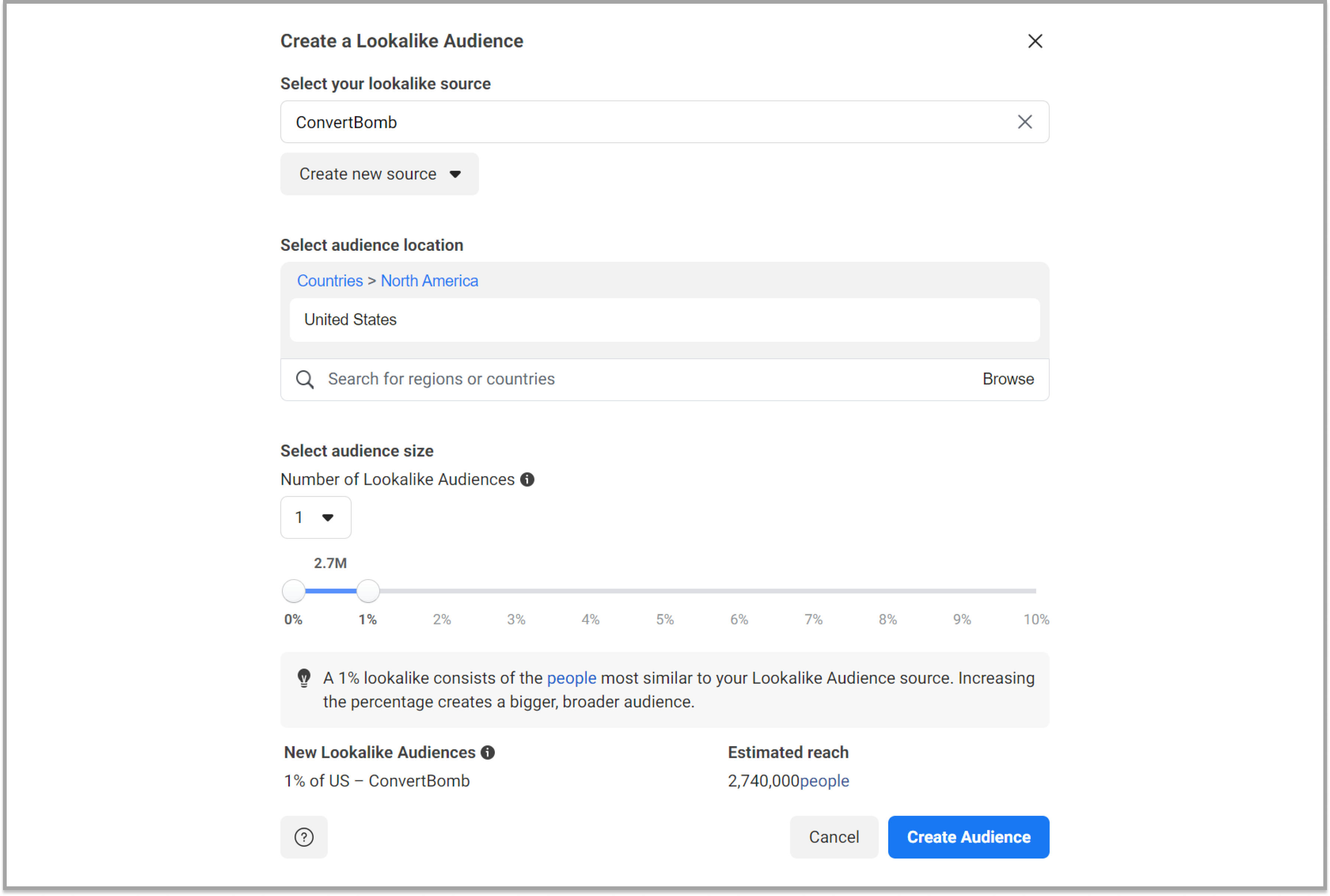
Here's how you can create a lookalike for your Facebook ad campaigns.
For example, you can choose a group of top-paying customers or people who interact with your business the most, choose the country where you want to find more people like them, and decide how big your lookalike should be. You can pick a higher percentage for your lookalike to include more different people in it, or select a smaller percentage to get a closer match to your source audience.
Note that it might take 6–24 hours for Facebook to make your new audience, and it will be refreshed every 3–7 days as long as you're still using it. This ensures the continuous process of discovering new viable audience segments, which is great if you’re looking to explore new targeting approaches.
4. Advantage+ audiences
This is a new addition to the existing targeting options on Facebook that were introduced not so long ago. Basically, Advantage+ Audience is one of the Facebook tools that uses smart technology to figure out your optimal target audience.
Facebook’s algorithms will learn from your past advertising results and your Pixel data, figuring out who clicked on your ads the most, purchased more than other, and so on. Then, it will use this data to find similar people. Facebook can do this automatically, or you can provide it with your Audience suggestions: custom and lookalike audiences, demographic parameters, etc. As Facebook claims, this gives Meta AI more data to work with thanks to the broad scope of the audience.
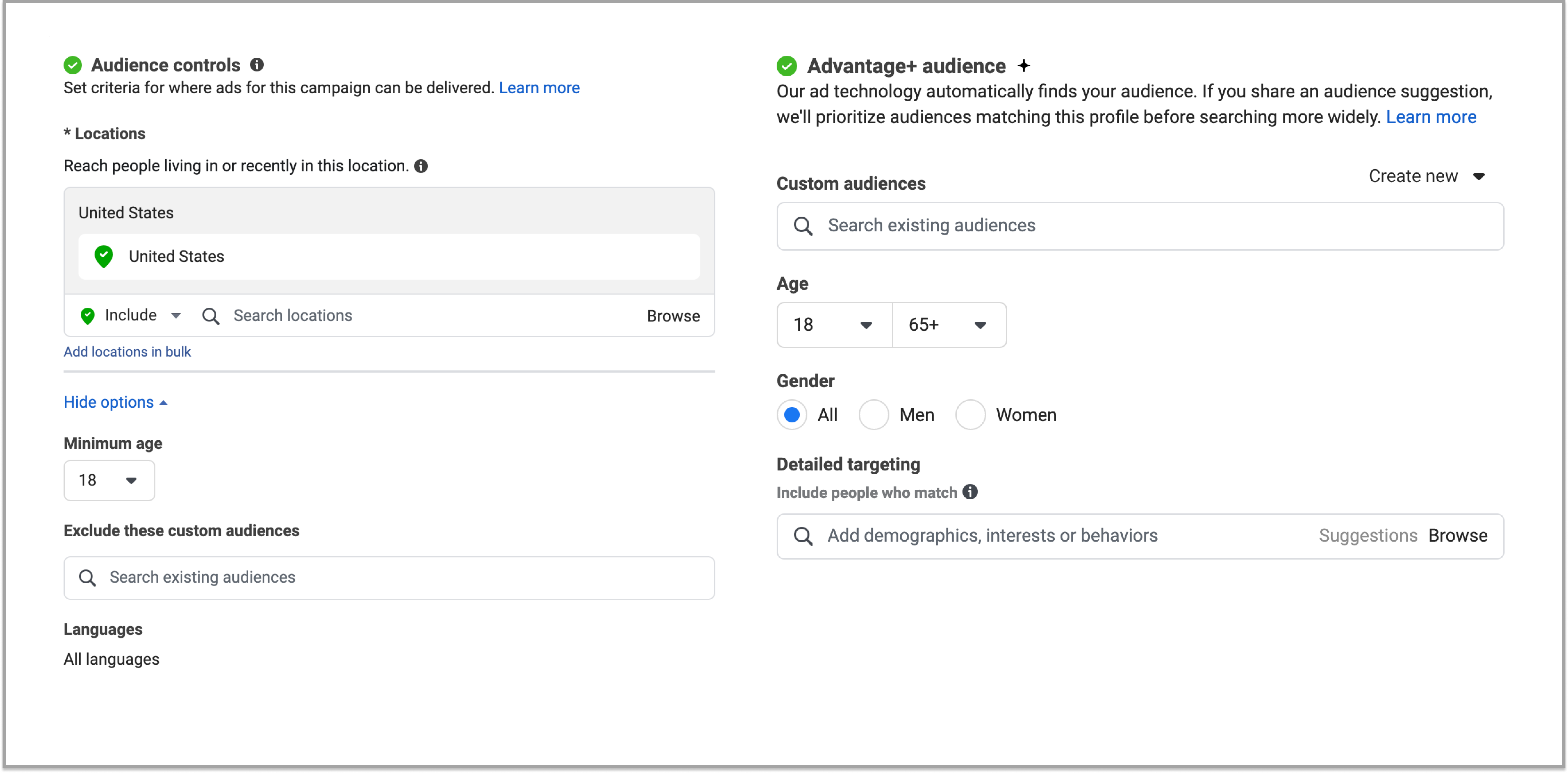
On Facebook, you can choose to let its algorithms find the best audiences for your ads, or set a specific criteria for targeting.
Advantage+ audiences also provide several benefits for running Facebook ads, like potentially lower costs per result and the ability to exclude certain groups from your targeting. However, the Advantage+ audiences won’t work as well for retargeting campaigns, so it’s best to use them when you’re targeting the top-of-the-funnel audiences and can afford some experimentation.
Facebook recommends testing Advantage+ audiences to compare their performance with your regular audiences and make the right choice.
As you can see, Facebook provides plenty of opportunities for advertisers to reach the right audiences with their ad campaigns. But should you choose a more precise audience, or go with a more general one?
Broad vs. narrow targeting: how to target the right audience with Facebook ads?
There are many opinions about whether to go broad for Facebook advertising or select more precise audiences to get better results. Facebook itself often recommends keeping your audience broad to let its algorithms collect the necessary data to allow you to improve ad performance.
However, both broad and narrow audiences in Facebook ads come with their own set of advantages and disadvantages, so let’s consider them.
Here are the pros of broad audiences on Facebook:
- Wider reach: broad audiences allow you to reach a large number of people, which can help you increase visibility and brand awareness.
- Potential for virality: with a broader audience, there's a higher chance of your ads being shared and going viral, reaching even more people.
- Discovery of new audiences: broad targeting can help you discover new audience segments that you may not have considered before.
- Simplified campaign management: managing campaigns with broad targeting can be simpler since they require less segmentation.
When it comes to cons, broad audiences have several disadvantages:
- Lower relevance: ads shown to a broad audience may not be as relevant as those more tailored to specific audience segments, leading to lower engagement and conversion rates.
- Wasted ad spend: a portion of your ad spend may be wasted on users who are not interested in your products or services, which can lower your Facebook ads’ ROI.
- Limited control: less control over who sees your ads may result in less targeted messaging and missed opportunities for generating more conversions.
Now, here are the pros of narrow audiences:
- Higher relevance: narrow audiences help you ensure that your ads are highly relevant to a specific group of people, increasing engagement and conversion rates.
- Cost-effectiveness: targeting specific audience segments can lead to lower costs per conversion, as you're only reaching users who are likely to be interested in your offerings.
- Better ad performance: ads shown to a narrow audience are more likely to resonate with the viewers, leading to better ad performance and ROI.
- Improved ad personalization: narrow targeting allows for more personalized ad messaging tailored to the interests and needs of the audience.
But narrow audiences also come with disadvantages:
- Limited reach: narrow audiences may result in limited reach, especially if the targeting criteria are too restrictive.
- Complex campaign management: managing campaigns with narrow targeting requires more segmentation and monitoring, which can be time-consuming.
- Missed opportunities: overly narrow targeting may cause you to miss out on potential customers who fall outside of your defined audience segments.
- Difficulty in scaling: scaling campaigns with narrow targeting can be challenging, as it may be difficult to find additional audience segments that meet your criteria. Mainly, the choice between broad and narrow targeting will depend on your campaign objectives, budget, and the level of control and customization you want.
One possible solution to this dilemma is to find a balance between the two. You can consider what is more important for you to make the right choice:
- Reaching more people vs. being relevant: showing your Facebook ads to lots of people can help you get more views, but if the ads aren't relevant to everyone, it'll be a waste of budget. Narrowing down who sees your ads can make them more likely to be interested and take the right action while limiting reach at the same time.
- Saving money: when you show ads to a large group of people, it might cost a lot more, and you won’t have a guarantee that you’ll get many conversions. Targeting specific groups can be cheaper and more effective, but in some cases, it can be difficult to get enough results with a limited audience.
- Keeping things fresh: if you keep showing the same ad to people over and over again, they might get tired of it, especially in the case of narrow audiences. Mixing broad and narrow targeting can help you show different ads to different groups.
All of this can sound a bit abstract, so let’s imagine a specific scenario: you’re advertising a business that sells women’s bags. Logically, your first choice for Facebook targeting will be women, and you might also apply location filters if you only ship to or have stores in certain areas, income level, interests, or behaviors if you’re selling luxury bags, etc.
However, selecting this kind of target audience can lead you to miss out on a lot of potential conversions. How? For instance, women’s bags can be interesting not just to women but to men as well: for starters, they might be looking for gifts for their loved ones, which means that they can also become your customers. There are many other cases when going too narrow can prevent you from getting better results.
That’s why it’s crucial to analyze your audience properly to discover all potential customers, even if they’re don’t conform to your typical buyer personas. But you also don’t want to advertise to everyone and everywhere at the same time to keep your ads relevant. The best course of action in this situation is to create ad campaigns tailored to different audience segments so that you won’t leave anyone out.
Next, let’s move on to the specific tips and strategies for effective Facebook ad targeting.
Key Facebook ad targeting strategies
As with other aspects of Facebook advertising, selecting the right target audience is usually done through trial and error. Most likely, you won’t be able to make the right choice right from the get go, but don’t worry: the strategies below can help you speed up the process and figure out the best targeting approach for your Facebook ad campaigns.
Here are the key tips for effective audience targeting on Facebook:
1. Go broad to figure out your primary audience
If you’re just starting out with your Facebook ad campaigns and still unsure who you should target, consider choosing broad targeting to figure this out.
While narrow and precise targeting helps you aim your ads at the people who are more likely to want what you offer, broad targeting allows you to reach more people with your ads and discover what they like and don’t like, and how they feel about your business.
This can give you a lot of valuable insights: you might find out that people you didn't think would be interested actually are, see that certain offers, ad creatives, and placements work better for specific groups of people, and so on. Once you have this new data, you can adjust your approach and start segmenting your audience.
2. Segment your audience
Segmenting the audience can be important for your Facebook ads’ success because it allows you to tailor your ads to specific groups of people. By dividing the audience into smaller segments, you can create more personalized and targeted ads that resonate with each group. This not only increases the relevance of the ads but also increases engagement and conversion rates.
You can start by finding the right audience for your products or services, running ad campaigns for it, and then analyzing the data and behavior of users to separate the overall audience into specific segments based on different characteristics.
For example, you can check which groups of people are more likely to make repeat purchases or spend more money and focus on running ad campaigns with higher spend tailored to them, maximizing your ROI as a result.
Here’s how you can segment your audience for more effective ad campaigns:
- Understand your customers: take the time to understand who your customers are and what they're interested in. This helps you create segments that are tailored to their specific needs and preferences.
- Segment based on behavior: divide your audience into segments based on their behavior, such as past purchases, website visits, or interactions with your ads. This allows you to target each segment with ads that are relevant to their actions.
- Use demographic data: segment your audience based on demographic factors like age, gender, location, and income level. This helps you create targeted ads that resonate with specific demographic groups.
- Consider the customer lifecycle: think about where your customers are in the buying journey and segment your audience accordingly. For example, you might have separate segments for new leads, repeat customers, and lapsed customers, each requiring a different approach.
Segmenting your audience also allows you to go more narrow, if that’s what you need. For example, you can try niche targeting and select specific interests relevant to your product or service to reach a more engaged audience. You can also layer interests and other targeting options to narrow down your audience even more and increase relevancy.
3. Use retargeting to increase conversion rate
Creating custom audiences helps you find specific people who have interacted with your business before. You can show them ads that are personalized based on what they've done in the past, which makes it more likely that they'll come back to your website and buy something.
Here are some recommendations for using custom audiences for retargeting on Facebook ads:
- Target website visitors: you can create a custom audience of people who have visited your website – they are already interested in your business, so showing them ads can remind them to come back. For example, you can target users who’ve added items to their carts but then abandoned them and offer them a special discount or a deal to make them convert.
- Retarget app users: if you have a mobile app, create a custom audience of users who have interacted with your app. This can help bring them back to your app or encourage them to take further action.
- Segment based on actions: divide your custom audience into segments based on their actions, such as people who added items to their cart but didn't purchase. This allows you to show targeted ads based on their specific behavior.
- Exclude recent purchasers: to avoid showing ads to people who have recently made a purchase, create a custom audience of recent customers and exclude them from your retargeting campaigns.
- Upload customer lists: you can create custom audiences by uploading customer lists that can include email addresses, phone numbers, etc., to target existing customers or leads. Keep in mind that some users might not get matched with the data, which means your targeting can be less precise.
- Use Facebook sources: besides your own sources, you can also select options provided by Facebook, like videos, events, Facebook pages, and so on. These options can be a better choice after the iOS 14 update because Facebook owns this data.
Custom audiences are great for retargeting, i.e. for reaching warm audiences. If, on the other hand, you want to populate the top levels of your conversion funnel, you can exclude your current customers from your audiences to run bottom-of-the-funnel campaigns and reach cold audiences.
4. Find new customers with lookalikes
Lookalike audiences are great for increasing brand awareness as well as other top-of-the-funnel objectives, as they help you find users who are somewhat similar to your existing customer base.
Here’s how to use Facebook lookalike audiences effectively:
- Pick the right source audience: use a high-quality seed audience (e.g., the list of existing high-value customers) to create lookalike audiences with similar characteristics. However, keep in mind that the website-based audiences might not work as well as before, which means you have to consider other possible sources for your lookalikes (e.g., the list of people who liked your Page).
- Choose the right size: when creating your lookalike audience, choose a size that fits your goals. A smaller audience will closely match your source audience, while a larger audience will be broader but might include more potential customers.
- Test different percentages: experiment with different percentages to see which one works best for reaching new customers.
- Monitor ad performance: keep an eye on the performance of your lookalike audiences and adjust as needed. If you're not seeing the results you want, try refining your source audience or tweaking your targeting options (e.g., by changing the percentage).
With the right approach, you can use lookalike audiences to quickly discover new customer segments that you haven’t considered before and scale your ad campaigns.
5. Use targeting by location to reach customers in specific areas
Geographical targeting can be an excellent choice for both local businesses that want to reach people from specific areas and businesses with a presence in different regions that want to create more tailored ad campaigns.
Here’s how to use location targeting to maximize Facebook ad performance:
- Know your target market: understand where your target audience is located and focus your ads on those areas. This ensures that your ads are seen by people who are most likely to be interested in your product or service.
- Be specific: use precise location targeting (e.g., radius targeting) to reach users in specific cities, neighborhoods, or regions. This allows you to tailor your ads to the preferences and needs of local audiences.
- Consider local events and trends: take into account any local events or trends that may impact the effectiveness of your ads. For example, if there's a popular festival or holiday happening in a certain area, consider adjusting your ad targeting to capitalize on the increased local interest.
- Test different geographies: experiment with targeting different geographic locations to see which areas yield the best results for your ads. Test variations in city size, population density, and regional characteristics to find the most effective targeting strategy.
- Use location-based offers: create special offers or promotions that are specific to certain locations to encourage local customers to engage with your ads. This can help increase the relevance and effectiveness of your ads in those areas.
This way, you’ll be able to use location targeting effectively to reach specific local audiences with your Facebook ads and achieve better results for your campaigns.
6. A/B test different audiences
A/B testing is one of the most effective strategies for improving ad performance and maximizing your results, and it’s also useful if you want to discover the most profitable audience segments for your Facebook ads.
For example, if you're selling gym clothes on Facebook, you’ll want to know who's most interested in buying them. You can try showing the same ads to different groups of people: one group might include people who love to exercise, and another might be people who are interested in specific gym clothes brands.
As your Facebook ads run, you can check which groups click on your ads more and generate more conversions. Then, you can focus more on showing your ads to them in the future and segment the audience even further by discovering different groups within the original one.
Basically, you can test audiences with different demographics, interests, locations, behaviors, and so on, as well as compare various custom and lookalike audiences to find the most loyal customers and get a higher ROI from running ads for them. To learn more about testing your ads efficiently, check out our A/B testing guide.
7. Avoid audience overlap
Audience overlap is when the same people see your ads multiple times because they're in different groups you're targeting. This can negatively affect your ad performance because it increases ad fatigue and practically makes you bid against yourself in the ad auction.
Audience overlap can easily cause you to waste your money by showing ads to the same people over and over again. Besides, people can get tired of seeing your ads, so they'll be less likely to pay attention and convert.
To avoid this, you need to make sure you're not targeting the same people in different ad groups. Keep an eye on your campaigns and adjust your targeting if you notice any overlap by using the Audience Overlap tool on Facebook.
Recap
Hopefully, now you understand why targeting is so crucial for the success of your Facebook ads campaigns. Let’s break down the key reasons for this:
- Building conversion funnels that work: segmenting your audience into separate groups based on their level of engagement with your business and targeting them in different campaigns allows you to develop a full conversion funnel. This is essential for leading users all the way from their first interaction with you to making a purchase.
- Optimizing advertising costs: proper targeting helps you avoid wasting money as you show your ads only to people who are likely to be interested. This way, you can avoid spending your ad budget on irrelevant clicks and impressions and get a good cost per result.
- Getting more conversions: when your ads reach the right people, they're more likely to turn into actual customers. Whether you want people to visit your website, download your app, or buy something, targeting the right groups of people (e.g., those who are already familiar with your business) helps you make it happen.
- Creating better ads: Facebook rates the quality of your ads based on how well they match up with what people want to see. Targeting the right audience can help your ads score better, which means you'll pay less for your ads and they'll show up in better places.
- Personalizing your message: different groups of people like different things. Targeting lets you customize your ads for different types of people, so your message hits home with the right folks.
- Beating your competition: the right targeting approaches can help you find groups of people who might really like what you're offering and convert at higher rates. This can give you an edge over your competitors by reaching users they might miss or overlook.
In conclusion, targeting the right audience on Facebook is key to making sure your ads are seen by the people who are most likely to buy from you. Follow the tips in this article to become a pro at Facebook ad targeting and maximize your ROI.

